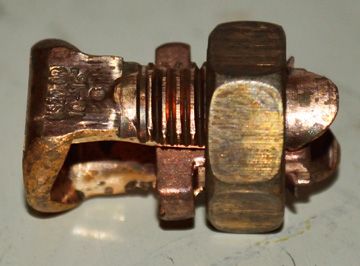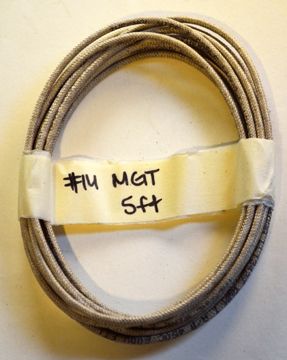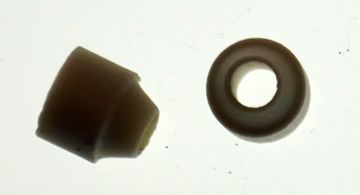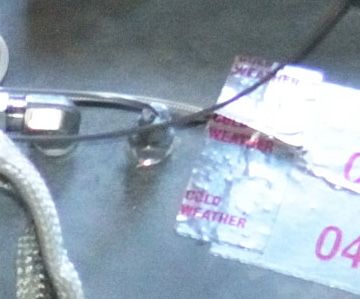LCD Display
Hi Excalibur
I`m trying to find lcd displays as you have for your temperatures but I just don`t seem to be able to find displays like that, can you give me a hint where to search for it?
I would like to have displays like that, that is easily readible from a distance.
The once I get it smaller and have two lines for the display.
I have ordered all the electronic parts, now I must just wait for it to arrive.
My flanges is being done, the moment I receive that I can start to build the machine.
Announcement
Collapse
No announcement yet.
How to turn plastic waste into diesel fuel cheaply
Collapse
X
-
My retort is an aluminum pressure cooker that does not use an elastomeric sealing system. The wall thickness is about 1/8" (3mm). I am doing vacuum distillation, so my vessels and tubing regularly see a 1 atmosphere pressure differential, and I have taken my pyrolysis unit to 400c several times with no evidence of distortion. I used to have 1/4" (6mm) brass fittings and copper tubing on it, but they distorted. I have since changed all of the fittings and tubing on the retort to stainless steel.Originally posted by Col View PostOk, so I've drawn up a smaller system to get the ball rolling. Figured I'd use 150mm diameter pipe for each chamber. Also figured heating with hot plates and band heaters will keep it simple(r) and easier to control during the learning curve. So spoke to a manufacturer of band heaters to get some advise. Initially he was surprised I was going to be putting 425C heat into a pipe only 4mm thick and suggested the pipe could warp and distort. Also that when people are working with temperatures that high they are usually die casting into blocks of steel with very thick walls, he recommended I use pipes of 10-12mm wall thickness. I explained there will be a constant flow of oil vapours passing through the system absorbing and taking away the heat. He thought that might be ok. My question is - has anyone had any of their system distort due to high heat? If so please share the details such as type and thickness of steel, which part, temperature reached etc. If no one has then that information is also useful.
At Chevron Research all of our cat cracking pilot plants used 1/4" to 3/8" (6mm-10mm) stainless steal tubing and compression fittings. The wall thickness of all of the retorts was about 1/8" (3mm). We even had pilot plants that were all standard Pyrex glassware, so I see no reason to use any wall thickness greater than 1/8" (3mm). Therefore non-galvanized, standard steel tapered fitting and nipples plumbing fittings should work just fine. Whereas, old oil drums and water heaters do not have sufficient wall thickness.
I have 2 mica band heaters on my retort. They are specified for 2400F (1300c) service. I have had no problem with them.Originally posted by Col View PostTo those using mica band heaters, how hot can they go? Have you had to replace any? I understand mica is ok to 300-350C but if you want to go hotter than that you need to use ceramic band heaters, which will go up to 450C.
It depends upon your hot plate. Most hot plates designed for residential use will burn up at our retort temperatures. However, the thick electric coil that goes on a standard American-style electric range can easily go to 425C and more; however, the electric hookup to that electric coil was a bit of a challenge, I ended up using the copper clamping system commonly in use in high amp electric service panel applications with no problems.Originally posted by Col View PostI was just going to sit my retort and first condenser on hot plates and wrap my retort, reflux and first condenser in one large band heater each, all governed by temperature probes. Should be able to control temperatures in each chamber very well that way.
Thank you, Col.
[IMG] [/IMG]
[/IMG]
The hookup wire I used had to be special kiln wire, which appears to be stranded chrome plated copper wire, but it might be an exotic copper alloy of some kind. It was VERY pricey, but well worthy it.


You will also want ceramic bead (fish spine) for high temperature electrical insulation.

I have placed all of the control probes directly underneath the heaters, so that the heater does not exceeded my control point. I have separate PID controllers controlling each heater. If you do not put the control probe on the heater then you will get hot spots. If you are using all steel fittings and retort, with 1/8" (3mm) thick walls, then you can take it up to 1200F (650c) if you want.Originally posted by Col View PostHas anyone put temp probes onto the wall and also into the middle of their retort or reflux? I'm interested to know if the temperatures are different and why (insulation, packing, direction of vapour flow...), and how large a diameter you can go before any difference becomes a problem.
In addition to control probes, I also have several monitoring probes so that I can closely monitor boiling, reflux and condensation. So, I have TC probes throughout my system. One just 1" (2.5cm) from the bottom of my retort. One at the exit of the vapor stream, then one at the bottom of each condenser trap, and one at each of their exits.

Leave a comment:
-
Temperature at shell v core of chamber
Has anyone put temp probes onto the wall and also into the middle of their retort or reflux? I'm interested to know if the temperatures are different and why (insulation, packing, direction of vapour flow...), and how large a diameter you can go before any difference becomes a problem.
Leave a comment:
-
Chamber distortion
Ok, so I've drawn up a smaller system to get the ball rolling. Figured I'd use 150mm diameter pipe for each chamber. Also figured heating with hot plates and band heaters will keep it simple(r) and easier to control during the learning curve. So spoke to a manufacturer of band heaters to get some advise. Initially he was surprised I was going to be putting 425C heat into a pipe only 4mm thick and suggested the pipe could warp and distort. Also that when people are working with temperatures that high they are usually die casting into blocks of steel with very thick walls, he recommended I use pipes of 10-12mm wall thickness. I explained there will be a constant flow of oil vapours passing through the system absorbing and taking away the heat. He thought that might be ok. My question is - has anyone had any of their system distort due to high heat? If so please share the details such as type and thickness of steel, which part, temperature reached etc. If no one has then that information is also useful.
To those using mica band heaters, how hot can they go? Have you had to replace any? I understand mica is ok to 300-350C but if you want to go hotter than that you need to use ceramic band heaters, which will go up to 450C. I was just going to sit my retort and first condenser on hot plates and wrap my retort, reflux and first condenser in one large band heater each, all governed by temperature probes. Should be able to control temperatures in each chamber very well that way.
Thank you, Col.
Leave a comment:
-
What You say is absolutely right . One can think of 2" retort size for continuous pyrolysis . This depends on the capacity of pyrolysis per minute , heat input .Originally posted by Beyond Biodiesel View PostPrecisley, this is why I have been focusing upon a 5 gallon (20L) system.
The solution is to improve your reflux
There is no reason why a continuous feed flash evaporator should be complicated or expensive to make. I have been reflecting upon the concept for about 2 years, and it is starting to look to me like the retort could be as small as a section of 2" pipe and a few plumbing fittings, which should be available at any hardware store. However, I would recommend avoiding galvanized pipe, and prefer stainless steel pipe and fittings, but black iron would do just fine.
I have designed 5 M.T / 24 HOUR CAPACITY continuous plant . and my retort size of dia. 300 mm . I am going for direct dual gas/oil fired burner and avoiding hot air generator . The best way is going for microwave heating but the cost of system is very high .
Leave a comment:
-
Hi Jetis,
Thank you so much for what you've made available here! This will for sure help solve major problems. I am working to replicate what you've done and build a system now.
I've been looking through the threads and trying to find reference to a safety valve. Question is:
1- have you considered where is a good place to put a safety valve to minimise risk, and
2- on the blest machine there doesn't seem to be a bubbler, is there something else in system to clean the off-gas before cooling in to fuel?
ThanksLast edited by neophite; 03-21-2014, 01:20 PM.
Leave a comment:
-
Hmm, yes I am beginning to see the value of building a smaller system first. Think I'll shelve the bigger one for the moment and test theories and ideas on a smaller scale first.
Col
Leave a comment:
-
Precisley, this is why I have been focusing upon a 5 gallon (20L) system.Originally posted by Col View PostA continuous set up allows for a smaller reactor. Instead of boiling say 100L in an 8 hour batch run you can drip 100L onto a hot plate at 1.67L per minute. Asad said he has his oil go from feed stock to vapour within a few minutes so in this example that represents just 5L in the retort at any one time. Surely this is safer than a 100L retort? Pfaulder reckons they get their feedstock evaporated within seconds.
Downstream the system is the same as a batch system so no safety differences there. Is it upstream that you are concerned about? Having a bulk tank feeding to a hot system? Or is it the possibility of air entering a continuous feed system? I'd like to address any potential issue before fabrication.
Col
The solution is to improve your refluxOriginally posted by Excalibur View PostI'd bet there'd be some good set ups that could be engineered to make the flash evaporation concept work to good effect. Balanced matching of feed to heat applied might be something to look at. If my experiences of flash-boil-over events are anything to go by, then the carbon is going to come out with the product. I reason that if the feedstock oil is frothing in typical boil over fashion then a reflux will be completely ineffective.
There is no reason why a continuous feed flash evaporator should be complicated or expensive to make. I have been reflecting upon the concept for about 2 years, and it is starting to look to me like the retort could be as small as a section of 2" pipe and a few plumbing fittings, which should be available at any hardware store. However, I would recommend avoiding galvanized pipe, and prefer stainless steel pipe and fittings, but black iron would do just fine.Originally posted by AAS View PostHi Col
Your argument is sound. I agree the size of the reactor can be allot smaller.
The next section is just my thoughts and not meant to offend anyone:
My philosophy is to keep things simple, less specialized parts mean less variables that may go wrong. If you want to commercialise the process the benefits of a continuous process in MY OPINION does out way the negatives.
However in a third world environment such as africa, robustness and simplicity goes a far way.
Leave a comment:
-
Hi ColOriginally posted by Col View PostThank you Excalibur, AJ and BBD
Congratulations on great progress AJ!
A continuous set up allows for a smaller reactor. Instead of boiling say 100L in an 8 hour batch run you can drip 100L onto a hot plate at 1.67L per minute. Asad said he has his oil go from feed stock to vapour within a few minutes so in this example that represents just 5L in the retort at any one time. Surely this is safer than a 100L retort? Pfaulder reckons they get their feedstock evaporated within seconds.
Downstream the system is the same as a batch system so no safety differences there. Is it upstream that you are concerned about? Having a bulk tank feeding to a hot system? Or is it the possibility of air entering a continuous feed system? I'd like to address any potential issue before fabrication.
Col
Your argument is sound. I agree the size of the reactor can be allot smaller.
The next section is just my thoughts and not meant to offend anyone:
My philosophy is to keep things simple, less specialized parts mean less variables that may go wrong. If you want to commercialise the process the benefits of a continuous process in MY OPINION does out way the negatives.
However in a third world environment such as africa, robustness and simplicity goes a far way.
Obviously not saying I won't ever consider a continuous process, just think for any novice(myself included) please be very CAREFUL and rather build a batch setup first before considering a continuous process right of the bat.
Regards
AJ
Leave a comment:
-
I'd bet there'd be some good set ups that could be engineered to make the flash evaporation concept work to good effect. Balanced matching of feed to heat applied might be something to look at. If my experiences of flash-boil-over events are anything to go by, then the carbon is going to come out with the product. I reason that if the feedstock oil is frothing in typical boil over fashion then a reflux will be completely ineffective.
A thought occurred as to a possible set up. Don't fit a reflux but have the outgoing product drop directly into a vessel which is heated to 300*C-350*C.
This vessel would then become the distiller so once any diesel has been boiling out, the remainder can be dropped back into the retort for re-cracking. This idea should work because the retort-outgoing-product is a mixture of cracked hydrocarbons, some of which are now in the diesel range. Heating to the aforementioned temperature will evap them.
If it was me, I'd be making a model to prove the concept. I think that making from 4" exhaust tube would be reasonably easy. Run numerous TC probes to monitor temps and use LPG heat for convenience. Make changes to dimensions, etc and retest. The object of spending the time at this stage is to get a good result that can then be scaled up.
Leave a comment:
-
Thank you Excalibur, AJ and BBD
Congratulations on great progress AJ!
A continuous set up allows for a smaller reactor. Instead of boiling say 100L in an 8 hour batch run you can drip 100L onto a hot plate at 1.67L per minute. Asad said he has his oil go from feed stock to vapour within a few minutes so in this example that represents just 5L in the retort at any one time. Surely this is safer than a 100L retort? Pfaulder reckons they get their feedstock evaporated within seconds.Originally posted by AAS View PostIf you want to upscale, I would not advice a continuous setup, bigger reactor = such a bigger BOOM if things go wrong. Keep it simple with a batch reaction. We are all DIY guys here and safety is important.
Downstream the system is the same as a batch system so no safety differences there. Is it upstream that you are concerned about? Having a bulk tank feeding to a hot system? Or is it the possibility of air entering a continuous feed system? I'd like to address any potential issue before fabrication.
Col
Leave a comment:
-
In response to resent comments regarding continuous feed flash evaporation, the retort volume would function as the reflux zone. The retort size would need to be large enough to accommodate all of the coke accumulation until a scheduled cleaning cycle. So, my retort is 5gallons (20L) I observe only a thin film of black coke on each 5-gallon (20L) run. So I reason that I could use it as a flash evaporator to distill a few hundred gallons (x4L) of WMO before a cleaning cycle.
Leave a comment:
-
I find these graphite gaskets to be invaluable.Originally posted by AAS View PostRope graphite gasket.Attached Files
Leave a comment:
-
Hi ChrisOriginally posted by Chris@NL View PostI have already have one extruder wich i can use. It only needs a electric motor.
This is the difficult part because normally these machines are driven by hydraulic engines. around 150 to 300 rpm.
As i already explained i have a recycling company and i have a few granulators and shredders.
I would like to ask AAS if he can make a detailed photoshoot of his installation.
I have my eye now on a used ceramic oven of 70 Liters. It only costs €150.
There is nothing special about my pilot plant, just an upscaled version of the original concept.
If you want to upscale, I would not advice a continuous setup, bigger reactor = such a bigger BOOM if things go wrong. Keep it simple with a batch reaction. We are all DIY guys here and safety is important.
I invested allot of time on my plant and will give advice freely, but I will not give my "blue prints" that is part of the fun.
What I can say is, if you want to go bigger, stainless steel is king and a minimum of 10mm thickness everywhere! mechanical seals of reactor lid and I use additional graphite rope gasket.
Regards
AJ
Leave a comment:
Leave a comment: